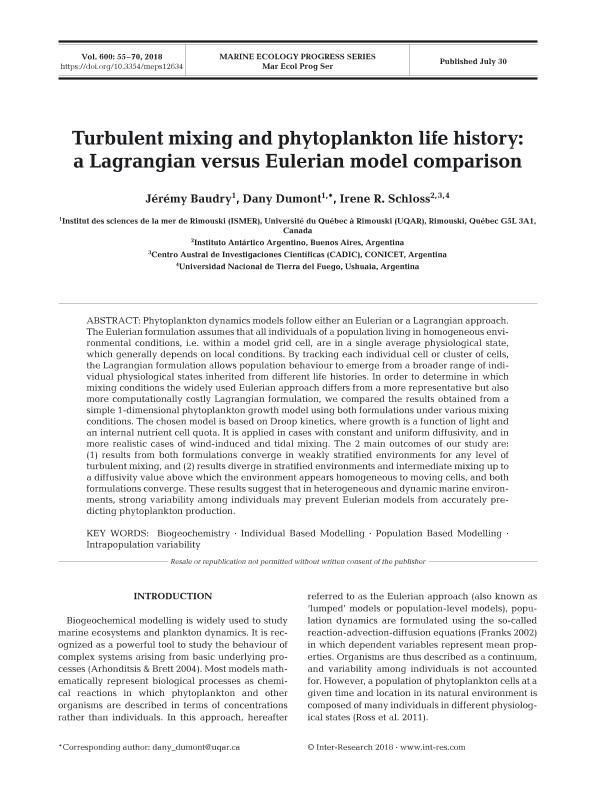Mostrar el registro sencillo del ítem
dc.contributor.author
Baudry, Jérémy
dc.contributor.author
Dumont, Dany

dc.contributor.author
Schloss, Irene Ruth

dc.date.available
2019-10-21T21:43:16Z
dc.date.issued
2018-07-30
dc.identifier.citation
Baudry, Jérémy; Dumont, Dany; Schloss, Irene Ruth; Turbulent mixing and phytoplankton life history: A Lagrangian versus Eulerian model comparison; Inter-Research; Marine Ecology Progress Series; 600; 30-7-2018; 55-70
dc.identifier.issn
0171-8630
dc.identifier.uri
http://hdl.handle.net/11336/86778
dc.description.abstract
Phytoplankton dynamics models follow either an Eulerian or a Lagrangian approach. The Eulerian formulation assumes that all individuals of a population living in homogeneous environmental conditions, i.e. within a model grid cell, are in a single average physiological state, which generally depends on local conditions. By tracking each individual cell or cluster of cells, the Lagrangian formulation allows population behaviour to emerge from a broader range of individual physiological states inherited from different life histories. In order to determine in which mixing conditions the widely used Eulerian approach differs from a more representative but also more computationally costly Lagrangian formulation, we compared the results obtained from a simple 1-dimensional phytoplankton growth model using both formulations under various mixing conditions. The chosen model is based on Droop kinetics, where growth is a function of light and an internal nutrient cell quota. It is applied in cases with constant and uniform diffusivity, and in more realistic cases of wind-induced and tidal mixing. The 2 main outcomes of our study are: (1) results from both formulations converge in weakly stratified environments for any level of turbulent mixing, and (2) results diverge in stratified environments and intermediate mixing up to a diffusivity value above which the environment appears homogeneous to moving cells, and both formulations converge. These results suggest that in heterogeneous and dynamic marine environments, strong variability among individuals may prevent Eulerian models from accurately predicting phytoplankton production.
dc.format
application/pdf
dc.language.iso
eng
dc.publisher
Inter-Research

dc.rights
info:eu-repo/semantics/openAccess
dc.rights.uri
https://creativecommons.org/licenses/by-nc-sa/2.5/ar/
dc.subject
BIOGEOCHEMISTRY
dc.subject
INDIVIDUAL BASED MODELLING
dc.subject
INTRAPOPULATION VARIABILITY
dc.subject
POPULATION BASED MODELLING
dc.subject.classification
Otras Ciencias Naturales y Exactas

dc.subject.classification
Otras Ciencias Naturales y Exactas

dc.subject.classification
CIENCIAS NATURALES Y EXACTAS

dc.title
Turbulent mixing and phytoplankton life history: A Lagrangian versus Eulerian model comparison
dc.type
info:eu-repo/semantics/article
dc.type
info:ar-repo/semantics/artículo
dc.type
info:eu-repo/semantics/publishedVersion
dc.date.updated
2019-10-17T14:07:18Z
dc.journal.volume
600
dc.journal.pagination
55-70
dc.journal.pais
Alemania

dc.journal.ciudad
Oldendorf
dc.description.fil
Fil: Baudry, Jérémy. Institut des Sciences de la Mer de Rimouski; Canadá. Université du Québec à Rimouski; Canadá
dc.description.fil
Fil: Dumont, Dany. Institut des Sciences de la Mer de Rimouski; Canadá. Université du Québec à Rimouski; Canadá
dc.description.fil
Fil: Schloss, Irene Ruth. Consejo Nacional de Investigaciones Científicas y Técnicas. Centro Austral de Investigaciones Científicas; Argentina. Ministerio de Relaciones Exteriores, Comercio Interno y Culto. Dirección Nacional del Antártico. Instituto Antártico Argentino; Argentina. Universidad Nacional de Tierra del Fuego; Argentina
dc.journal.title
Marine Ecology Progress Series

dc.relation.alternativeid
info:eu-repo/semantics/altIdentifier/url/https://www.int-res.com/abstracts/meps/v600/p55-70/
dc.relation.alternativeid
info:eu-repo/semantics/altIdentifier/doi/http://dx.doi.org/10.3354/meps12634
Archivos asociados
